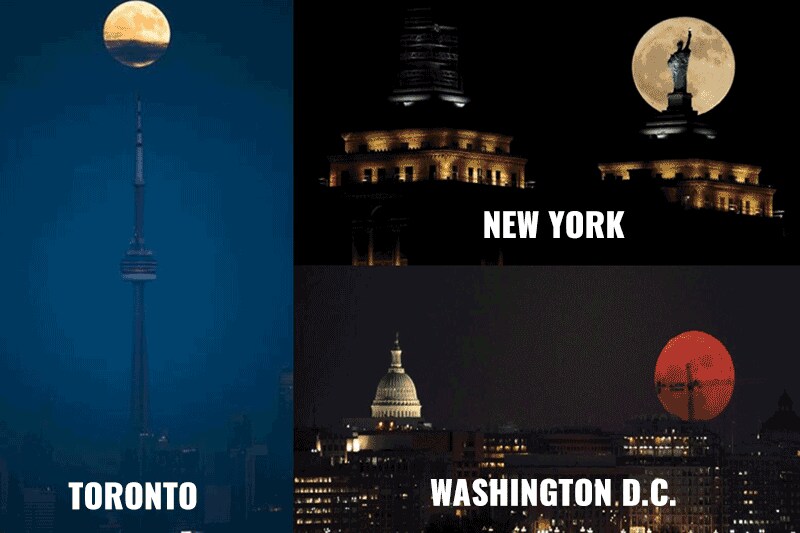
Stargazers were in for a treat last Sunday as they could catch a glimpse of the moon which was bigger than its usual size. When the Moon appears to be bigger and brighter in the sky as it moves closer to Earth, it is popularly known as the “supermoon”. The moon appears to be around 7 per cent larger tha usual and the celestial orb is also brighter with 15 per cent more brightness. The full moon in December is also known as the “cold moon”. The full moon on Sunday night marked the first and only supermoon of 2017. According to NASA, a supermoon is a Moon that is full when it is also at or near its closest point in its orbit around Earth. The next two will appear on January 1 and 31, 2018. In 2016, the Moon made its closest approach to Earth since 1948. It won’t be that close again until November 25, 2034. The Moon is seen as a rise in Washington, D.C., U.S. in this December 3, 2017, handout photo. The full Moon is the first of three consecutive supermoons. The two will occur on Jan. 1 and Jan. 31, 2018. A supermoon occurs when the moon’s orbit is closest (perigee) to Earth at the same time it is full. (Bill Ingalls/NASA/Handout.) -
The Supermoon rises above Whitby Abbey in Whitby, north-east England, Sunday, Dec. 3, 2017. The Dec. 3 full moon will be the first of three consecutive supermoons. (AP)
-
A supermoon rises in front of a replica of the Statue of Liberty sitting atop the Liberty Building in downtown Buffalo, N.Y., Sunday, Dec. 3, 2017. December's full moon appears bigger and brighter in the sky as it sits closer than average to Earth. Sunday's moon is the first of three consecutive supermoons. The next two will occur on Jan. 1, 2018, and Jan. 31. (AP Photo)
An aircraft taking off from Ronald Reagan National Airport is seen passing in front of the Moon as it rises in Washington, D.C., U.S. in this December 3, 2017 handout photo. The full Moon is the first of three consecutive supermoons. The two will occur on Jan. 1 and Jan. 31, 2018. A supermoon occurs when the moon’s orbit is closest (perigee) to Earth at the same time it is full. (NASA/Handout) -
The moon rises in its waxing gibbous stage behind a statue atop the Erie County Court Building, Saturday, Dec. 2, 2017, in Buffalo, N.Y. The Dec. 3 full moon will be the first of three consecutive supermoons. The two will occur on Jan. 1 and Jan. 31, 2018. A supermoon is a full moon or a new moon that approximately coincides with the closest distance that the moon reaches to Earth in its elliptic orbit, resulting in a larger-than-usual apparent size of the lunar disk as seen from Earth. (AP Photo)
-
The moon rises over the CN Tower and skyline in Toronto, Ontario, Saturday, Dec. 2, 2017. The Dec. 3 full moon will be the first of three consecutive supermoons. The two will occur on Jan. 1 and Jan. 31, 2018. A supermoon is a full moon or a new moon that approximately coincides with the closest distance that the moon reaches to Earth in its elliptic orbit, resulting in a larger-than-usual apparent size of the lunar disk as seen from Earth. (AP)
-
The supermoon rises as it is seen through an arch of the "Puente Nuevo" (New Bridge) in Ronda, southern Spain, December 3, 2017. (PHOTO: REUTERS/Jon Nazca)
The moon rises over a building in Netanya, Israel, Sunday, Dec. 3, 2017. The Dec. 3 full moon is the first of three consecutive supermoons. The other two will occur on Jan. 1 and Jan. 31, 2018. (AP Photo) -
The supermoon rises from behind the mountains in Imphal valley on Monday. Express photo by Oinam Anand. 14 November 2016. (PHOTO: Indian Express)
-
The full Moon on Saturday 19/03/2011 has been designated a 'supermoon' as it was the nearest approach of the Moon to Earth for the past 18 years, bringing it some 30,000 miles closer than usual. This Phenomenon is termed as Lunar Perigee. Pictures were taken with a skyscraper between 8.00 – 8.15 PM at Kandivali (E). (PHOTO: Mahendra Parikh, Indian Express)